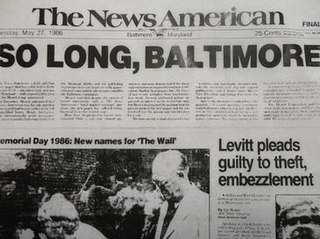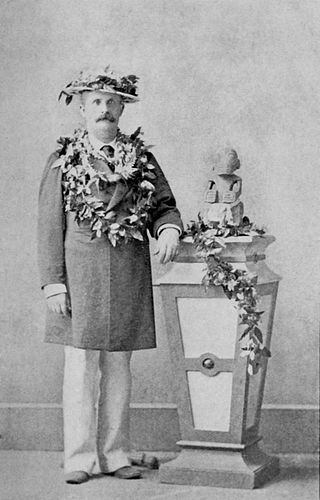
The Boston Herald is an American daily newspaper whose primary market is Boston, Massachusetts, and its surrounding area. It was founded in 1846 and is one of the oldest daily newspapers in the United States. It has been awarded eight Pulitzer Prizes in its history, including four for editorial writing and three for photography before it was converted to tabloid format in 1981. The Herald was named one of the "10 Newspapers That 'Do It Right'" in 2012 by Editor & Publisher.

The New York Herald was a large-distribution newspaper based in New York City that existed between 1835 and 1924. At that point it was acquired by its smaller rival the New-York Tribune to form the New York Herald Tribune.

The New York Journal-American was a daily newspaper published in New York City from 1937 to 1966. The Journal-American was the product of a merger between two New York newspapers owned by William Randolph Hearst: The New York American, a morning paper, and the New York Evening Journal, an afternoon paper. Both were published by Hearst from 1895 to 1937. The American and Evening Journal merged in 1937.

The Sun was a New York newspaper published from 1833 until 1950. It was considered a serious paper, like the city's two more successful broadsheets, The New York Times and the New York Herald Tribune. The Sun was the first successful penny daily newspaper in the United States, and was for a time, the most successful newspaper in America.

The Baltimore News-American was a broadsheet newspaper published in downtown Baltimore, Maryland until May 27, 1986. It had a continuous lineage of more than 200 years. For much of the mid-20th century, it had the largest circulation in the city.

Frank Andrew Munsey was an American newspaper and magazine publisher, banker, political financier and author. He was born in Mercer, Maine, but spent most of his life in New York City. The village of Munsey Park, New York is named for him, along with The Munsey Building in downtown Baltimore, Maryland at the southeast corner of North Calvert and East Fayette Streets.

The New York Evening Mail (1867–1924) was an American daily newspaper published in New York City. For a time the paper was the only evening newspaper to have a franchise in the Associated Press.

The Boston Evening Transcript was a daily afternoon newspaper in Boston, Massachusetts, published for over a century from July 24, 1830, to April 30, 1941.
The Boston Daily Advertiser was the first daily newspaper in Boston, and for many years the only daily paper in Boston.

The New York Globe, also called The New York Evening Globe, was a daily New York City newspaper published from 1904 to 1923, when it was bought and merged into The New York Sun. It is not related to a New York City-based Saturday family newspaper, The Globe, which was founded by James M. Place in 1892 and published until at least 1899.
Jason Rogers was an early 20th-century newspaper publisher best known for his success as a publisher of The New York Globe.

The Boston Evening Traveller (1845–1967) was a newspaper published in Boston, Massachusetts. It was a daily newspaper, with weekly and semi-weekly editions under a variety of Traveller titles. It was absorbed by the Boston Herald in 1912, and ceased publication in 1967.

The Newburyport Herald (1797–1915) was a newspaper published in Newburyport, Massachusetts in the 19th century. It began in 1797 with the merger of two previous newspapers, William Barrett's Political Gazette and Angier March's Impartial Herald. Employees included abolitionist William Lloyd Garrison and James Akin.
The Cincinnati Commercial Tribune was a major daily newspaper in Cincinnati, Ohio, formed in 1896, and folded in 1930.

The New York Evening Express (1836–1881) was a 19th-century American newspaper published in New York City.

William Nevins Armstrong, aka Nevins Armstrong and aka W. N. Armstrong, was the Attorney General of Hawaii during the reign of King David Kalākaua. He is most widely known outside of Hawaii for the book Around the World with a King, his insider account of Kalākaua's 1881 world tour.
The Boston Courier was an American newspaper based in Boston, Massachusetts. It was founded on March 2, 1824, by Joseph T. Buckingham as a daily newspaper which supported protectionism. Buckingham served as editor until he sold out completely in 1848, after suffering a severe financial crisis in 1837 and losing much of his editorial authority. The Boston Courier supported the National Republicans, and later the Whig Party. In the period before the American Civil War, its editors, including George S. Hillard and George Lunt, supported the states' right position on the abolition of slavery. From 1867 to 1915 the Boston Courier was a weekly newspaper published by Libbey & Dennison.













